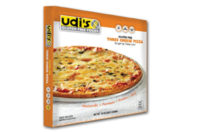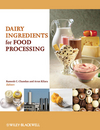2013 New Products Annual: Dairy
Dairy’s Evolution
While milk consumption continued its freefall, yogurt introductions would appear to be picking up the slack.










Even with Greek yogurt growing in American markets and consumers flocking to anything with live, active cultures, 2012 may be best remembered as a year associated with milk’s diminished role.
Last August, a U.S. Department of Agriculture report said domestic 2011 beverage milk sales tallied 53 billion pounds (roughly 6 billion gallons), the market’s poorest performance since 1984. Whole milk beverage sales in 2011 stood at less than half of 1980s’ levels, the report noted. It cited such factors as shifting consumer preferences and other new beverages.
Recognizing the challenge, the dairy industry has drawn a line in the sand around the breakfast daypart, as Americans continue to consume more milk at the breakfast table than any other meal. The industry also is relying upon chocolate milk’s protein, carbohydrates and sodium and—in some circles—industry leaders are positioning the drink as a sports recovery beverage.
For consumers concerned about the lactose in dairy milk, scientists at Inner Mongolia Agricultural University in China say they have bred the world’s first genetically modified calf that will produce low-lactose milk within two years. The fetus received a lactose dissolution enzyme, which dissolves the offending ingredient into galactose or glucose. Officials expect the calf, named Lakes, to produce low-lactose milk after she reaches 25 months of age.
Lactose concerns were not the only dilemma facing the milk industry in 2012. Late in the year, one report suggested too much milk consumption could be detrimental. When researchers at St. Michael’s Hospital in Toronto investigated milk intake and compared that with iron and vitamin D levels in 1,300 preschoolers, they found drinking two or more cups of milk a day seemed optimal. However, children who consumed more than two glasses a day risked lowering the amount of iron stored in their bodies and raised the risk for anemia. While the research, published in the journal Pediatrics, was unclear about whether drinking milk directly blocked iron absorption or if its impact was less direct, the researchers did suggest a two-cup-a-day limit, as recommended by the American Academy of Pediatrics.
On the other hand, Sweden’s University of Lund had better news for milk drinkers. Scientists there found milk protein (lactoferricin4-14) may reduce the growth rate of colon cancer cells, over time. The findings followed a number of studies relating milk consumption to improved health, notably a decreased risk of diabetes, metabolic syndrome and colon cancer.
That said, if there was a healthy star in the dairy universe in 2012, it would have been the continued probiotic phenomenon, and it is by no means limited to North America. A market report from Transparency Market Research, “Probiotics Market (Dietary Supplements, Animal Feed, Foods & Beverages)—Global Industry Analysis,” finds the global probiotics demand stood at $27.9 billion in 2011. Furthermore, the trend shows no sign of slowing. That report also predicts the global probiotics market will reach $44.9 billion by 2018, with a compound annual growth rate of 6.8% from 2013-2018, led by Asia-Pacific and Europe, with the former expected to be “the most promising market in the near future.”
Stateside, probiotic fortification continued unabated in 2012. Hain Celestial launched a low-fat kefir cultured milk under its Greek Gods brand. Greek Gods Kefir may be low in fat, but it also features 12g of protein, is gluten-free and 99% fat-free. The line also emphasizes honey, as the flavor factors in three of the four varieties: Honey, Honey Vanilla and Honey & Strawberry (in addition to plain). Extending the Greek Gods brand, popular in the Greek yogurt segment, gives Hain Celestial a familiar selling point among consumers in the growing kefir market.
That market has, by and large, been dominated by Lifeway Kefir, and that company also added a new flavor to the mix in 2012, although it was primarily a limited, seasonal option. Lifeway brought back its holiday-themed kefir smoothies and added a new flavor option to the bunch: Gingerbread, joining Pumpkin Spice and Cranberry Crème Brulee in the collection. Available only through December, each of the options promised 12 live and active cultures, including Lactobacillus lactis, Lactobacillus acidophilus, Streptococcus diacetylactis and Bifidobacterium lactis. They also were gluten-free and 99% lactose-free.
Yakult U.S.A. Inc. also added a probiotic-rich drink, Yakult Light. It features an active probiotic called Lactobacillus casei of the Shirota strain, a strain exclusive to the Yakult brand. Made with natural sweeteners and flavors, Yakult Light boasts no preservatives, gluten or high-fructose corn syrup, while it weighs in at 30 calories per bottle (compared to 50 calories in regular Yakult).
Greek to Everybody
How big is Greek yogurt? Less than three years ago, Greek yogurt sales accounted for roughly 3% of the overall yogurt category sales; in 2012, nearly one third of all U.S. yogurt sales are Greek varieties. And, analysts forecast the segment will grow 120% over the next five years.
Interestingly enough, those sales figures came from a category newcomer, the Jamba Juice retail chain. After doing its homework, Jamba entered the fray with a line of new Greek Yogurt Superfruit Smoothies. The new “at-home” offering combines non-fat Greek yogurt with on-trend superfruits pomegranate and açai. Pomegranate Pick-Me-Up features whole frozen blueberries and raspberries, sliced strawberries, pomegranate and frozen non-fat Greek yogurt, while Acai Super-Antioxidant features whole frozen blueberries, raspberries, sliced strawberries, blackberries, açai and non-fat Greek yogurt, each containing 130 calories or less per 8oz serving.
Elsewhere, General Mills added Yoplait Smoothies in Mixed Berry and Strawberry Banana Orange flavors—each with 10g of protein when prepared with milk—thereby delivering as much protein as one large egg, as well as 35% of the daily value of vitamin C and 25% of the daily value of calcium. Each 4.5oz freezer package contains frozen fruit, fruit juice and real Yoplait Greek yogurt to make one 12oz serving.
In addition to the incorporation into smoothies, Greek yogurt also found its way into a new product from Eat Well Enjoy Life. Officials say the new Hummus with Greek Yogurt features a garbanzo bean hummus mixed with Greek yogurt. The new line has five varieties: Classic Hummus with Greek Yogurt; Roasted Red Pepper Hummus with Greek Yogurt; Roasted Garlic Hummus with Greek Yogurt; Spicy Hummus with Greek Yogurt; and Roasted Pine Nuts Hummus with Greek Yogurt.
In the dairy case, SymphonyIRI said it expected Greek yogurt sales to account for 43% of the $4.6 billion U.S. yogurt market by the end of 2012. Nevertheless, there was one notable exit from the Greek yogurt arena; last April, Kraft Foods announced it would discontinue its Athenos Greek yogurt line.
Meanwhile, Greek yogurt giant Chobani continued its segment domination. For the record, Fast Company says Chobani boasted sales of more than $650 million in sales in 2011. In 2013, Chobani expects to continue the trend with well-publicized plans for more new products. New Chobani Flip will follow in the trend of ingredient mix-ins for yogurt. Each container’s lid can be flipped to reveal a compartment with flavored mix-ins. The 5.3oz options include Vanilla Golden Crunch (vanilla non-fat yogurt with cornflakes, honey oats and pecans); Key Lime Crumble (Key Lime low-fat yogurt with graham crumble and white chocolate); Strawberry Sunrise (strawberry non-fat yogurt with honey oats); Honey Beenana (honey low-fat yogurt with banana); Almond Coco Loco (coconut low-fat yogurt with dark chocolate and sliced toasted almonds); and Raspberry Choco Fix (vanilla chocolate chip low-fat yogurt with raspberries).
Chobani also is extending its Champions line, which is geared toward children. Champions Tubes are squeezable, on-the-go, Greek-style yogurt in four child-friendly flavors: Jammin’ Strawberry, Chillin’ Cherry, Rockin’ Blueberry and Swirlin’ Strawberry Banana.
Greek yogurt also merged with the organic trend in a new release from Straus Family Creamery. The company introduced what it claims is the market’s only non-GMO-verified and certified-organic Greek yogurt. Certified-kosher and gluten-free, the product features just two ingredients: organic milk and live, active cultures.
Greek or not, the yogurt category’s overall growth has outpaced the rest of the U.S. food industry, and U.S. sales are up 15% from 2010, according to Nielsen. A Barclays analyst report found that, of the current largest production capacity projects in the U.S. food industry, at least seven are in the yogurt sector, including two from Chobani, whose founder believes the U.S. market could double in size over the next few years. As Chobani CEO Hamdi Ulukaya noted in a conference call, America is still considered an underdeveloped yogurt market.
That market trend data was not lost on PepsiCo. In one of the bigger news stories of the year, PepsiCo entered the yogurt category in a joint venture with the Theo Muller Group. Muller Quaker Dairy brought Europe’s Muller yogurt to the States: Muller FrutUp is a parfait-style yogurt with a light, airy fruit mousse on top. Muller Corner features a two-chamber cup with yogurt in one chamber and mix-ins, such as fruit, caramelized almonds, crunchy cereal or chocolate, in the other. The latter boasts 10 varieties, including four thicker, creamier, Greek-style yogurt versions called Muller Greek Corner.
Last but not least, consumers also seem to be attracted to the idea of simplicity. General Mills expanded its Yoplait brand into Yoplait Simplait yogurt, crafted from a combination of six simple, all-natural ingredients, including cultured, pasteurized grade-A milk, fruit, sugar, corn starch, natural flavor, and a vegetable or fruit juice, or extract or pectin.
“Consumers are continually looking for new and different ways to enjoy the refreshing goodness of yogurt,” says Rachel Ringel, associate marketing manager, Yoplait Simplait. “There has been an increasing demand for simpler ingredient lists, but one thing remains constant—taste is the most important.” The line is available in four flavors: blackberry, peach, and strawberry and peach, each containing 7g of protein per 6oz serving.
The Frozen Chosen
Also frozen, but lacking the healthful panache of yogurt, several ice cream introductions did try to capitalize on health, to a degree.
Jambo Production LLC began operations last October and launched four flavors of Jambo Protein Ice Cream: Berry Burst, Java Gym Coffee, Chai Green Tea and Chocolate Bliss, all made with organic pasture-fed cows’ whey protein and featuring no lactose, gluten, GMOs, rBGH, added sugar or preservatives.
A similar product, Thrive Frozen Nutrition, from the company of the same name, promises as much protein as an egg, as much calcium as a cup of milk and as much potassium as a banana in each 250-calorie serving. In addition, the pharmacist-developed product boasts four live strains of probiotics and 24 vitamins and minerals. It is available in four flavors: homemade vanilla, milk chocolate, chocolate fudge and strawberry.
Active D’Lites also added to its line of probiotics-powered frozen confections with Vanilla Lite Ice Cream Bars. The bars are dipped in premium, European-style chocolate and made with GMO-free natural ingredients, as well as a blend of probiotics that promise to help promote and sustain digestive health.
Attempting to capitalize on the premium ice cream trend as well, Nestle test-marketed a new line of Willy Wonka-themed upscale ice cream, with such inclusions as potato chip bark pieces, pecan pralines and nut brittle. The inclusions may have been a bit too innovative, however, as the line was discontinued in early 2013.
One of the most innovative ice cream launches during the year came from Kaurina’s. Kulfi is a frozen dessert street food from India. Similar to ice cream in appearance and taste, it is typically denser and creamier, and the line includes such authentic flavors as Kheer (the Indian version of rice pudding), Malai (fresh ground cardamom spice blended into a pure, cooked milk base) and Chikoo (the texture of a ripe pear with a hint of cinnamon)
Looking for a reprint of this article?
From high-res PDFs to custom plaques, order your copy today!






